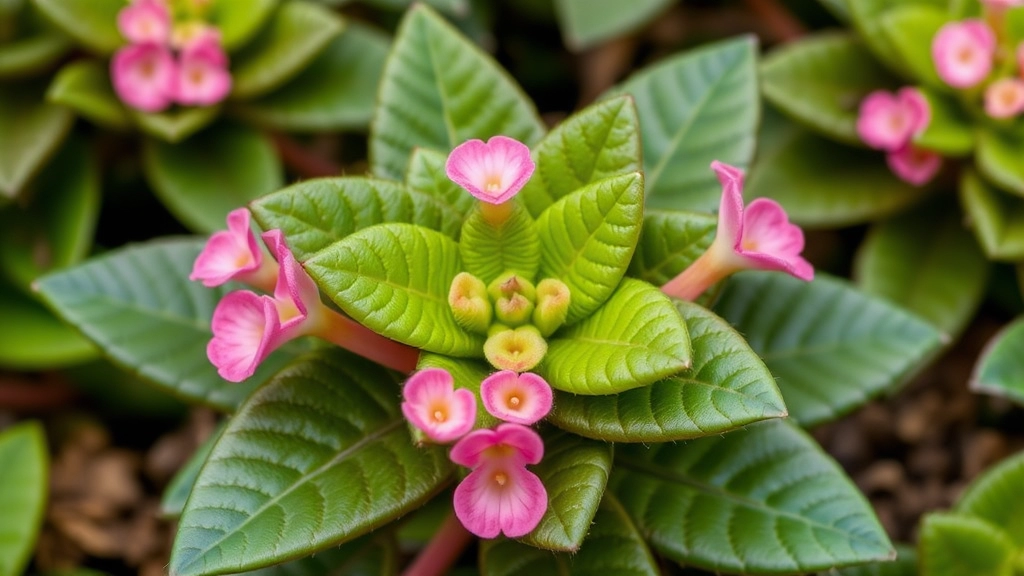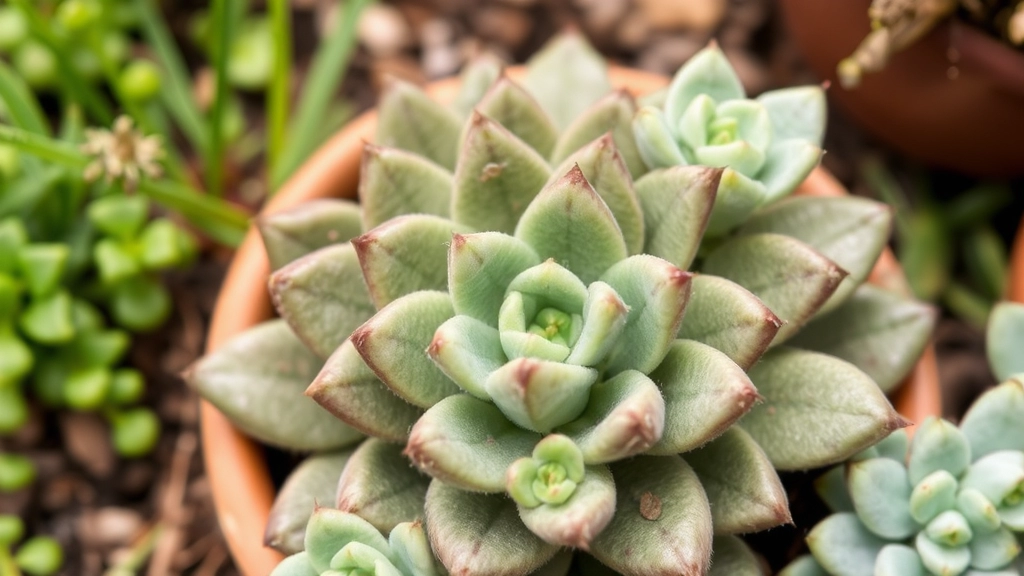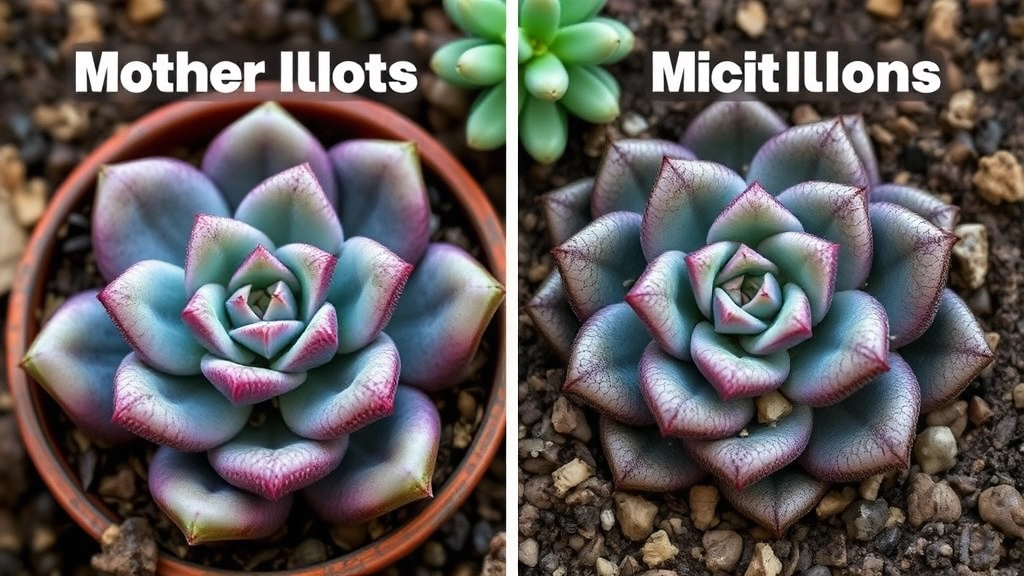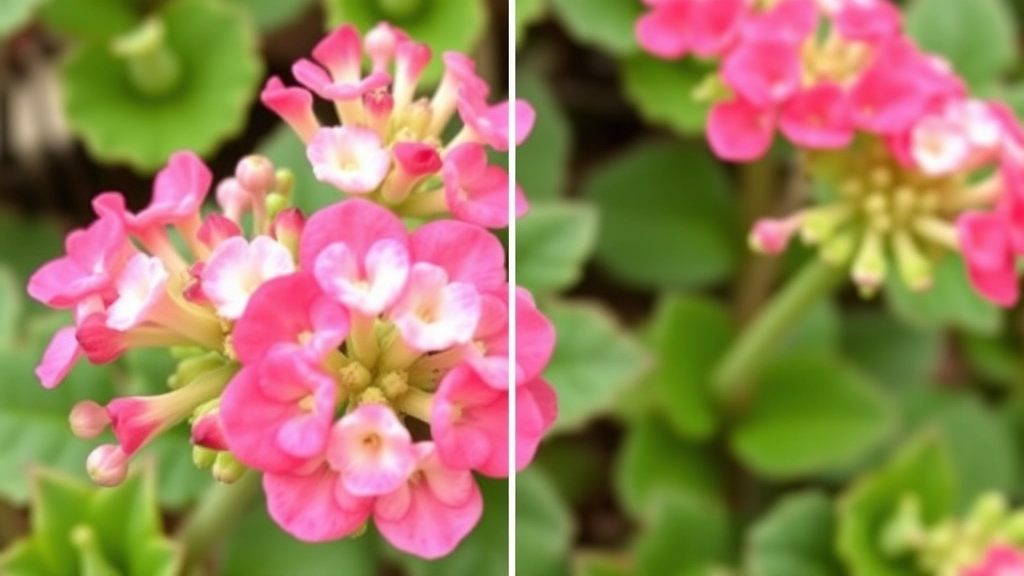Kalanchoe Mother of Thousands Varieties
When it comes to Kalanchoe Mother of Thousands varieties, the sheer diversity can be a bit overwhelming. As a succulent enthusiast, I’ve found that each variety has its own unique charm and care needs. From the classic Kalanchoe daigremontiana to the popular hybrids like Kalanchoe × houghtonii, there’s a lot to explore. These plants are known for their distinctive leaf patterns and easy propagation methods, making them a favourite among gardeners.
Understanding Growth and Care
Understanding the growth and reproduction patterns of different Kalanchoe varieties is key to keeping them healthy. They thrive in well-drained soil and require minimal watering, making them perfect for indoor settings. Whether you’re a seasoned gardener or a beginner, knowing the ideal growing conditions and common issues can make all the difference.
Dive into Kalanchoe Care
So, let’s dive into the fascinating world of Kalanchoe Mother of Thousands varieties and discover how to care for these incredible plants.
Key Varieties of Mother of Thousands Plant
Are you curious about the different types of Mother of Thousands plants?
This fascinating group of succulents, primarily belonging to the Kalanchoe genus, boasts several captivating varieties that are popular among gardeners and plant enthusiasts alike.
Kalanchoe daigremontiana
Often referred to as the classic Mother of Thousands, Kalanchoe daigremontiana is renowned for its unique leaf structure.
- Characteristics:
- Leaves are broad and fleshy, with small plantlets forming along the edges.
- Grows up to 1 meter tall.
- Habitat: Native to Madagascar, it thrives in warm, sunny environments.
Kalanchoe à houghtonii
This hybrid variety is a blend of Kalanchoe daigremontiana and Kalanchoe tubiflora.
- Features:
- Displays vibrant green leaves with a more compact growth habit.
- Known for its striking, tubular flowers.
- Popularity: Favoured for its ornamental appeal and ease of care.
Kalanchoe tomentosa
Commonly known as the Panda Plant, this variety is easily recognised by its fuzzy leaves.
- Appearance:
- Leaves are covered in fine hairs, giving them a soft texture.
- Produces small, bell-shaped flowers that add to its charm.
Each of these varieties brings its own unique flair to any plant collection, making them sought-after choices for both novice and experienced gardeners. If you’re interested in more detailed care instructions, check out our complete guide to Kalanchoe Mother of Thousands care and propagation. Additionally, for tips on growing and maintaining Kalanchoe tomentosa, visit our complete guide on how to care for Kalanchoe tomentosa.
Distinguishing Features of Kalanchoe daigremontiana

So, you’ve heard about the Mother of Thousands plant and are curious about Kalanchoe daigremontiana, right? You’re in the right place. This plant is not just another succulent; it has some standout features that make it truly unique.
Key Characteristics
- Leaves: The leaves are large, thick, and have a strikingly serrated edge. They can grow up to 30 cm long and have a bluish-green hue that gives them a distinct look.
- Offsets: One of the coolest things about Kalanchoe daigremontiana is its ability to produce tiny plantlets, or offsets, along the edges of its leaves. These little guys can fall off and root themselves, leading to a mini jungle in your pot!
- Flowers: When it blooms, it showcases clusters of tubular flowers that are usually a vibrant pink or red. They add a splash of colour, making this plant even more appealing.
- Growth Habit: This plant tends to grow upright and can reach a height of about 1 meter. It’s quite the eye-catcher in any garden or indoor space.
Fun Fact
Did you know that Kalanchoe daigremontiana is often called the “Chandelier Plant”? This nickname comes from the way its leaves hang down, resembling a chandelier. Pretty cool, right?
Why It Matters
Understanding these distinguishing features not only helps you appreciate the beauty of Kalanchoe daigremontiana but also aids in proper care. When you know what to look for, you can ensure your plant thrives.
Popular Hybrid Varieties: Kalanchoe à houghtonii
As we delve deeper into the world of Mother of Thousands, it’s essential to highlight the popular hybrid varieties that have captured the hearts of plant enthusiasts. One such hybrid is Kalanchoe à houghtonii, a remarkable cross that showcases the best traits of its parent species.
Overview of Kalanchoe à houghtonii
Kalanchoe à houghtonii is known for its striking appearance and unique characteristics. This hybrid often features:
- Leaf Shape: Its leaves are broader and more textured than those of Kalanchoe daigremontiana.
- Flowering: The flowers exhibit vibrant hues, typically in shades of orange or red, which can brighten any indoor space.
- Growth Habit: This variety tends to grow more compactly, making it suitable for smaller pots or as part of a mixed succulent arrangement.
Why Choose Kalanchoe à houghtonii?
Many plant lovers are drawn to Kalanchoe à houghtonii for several reasons:
- Aesthetic Appeal: The combination of lush foliage and bright flowers creates an eye-catching display.
- Ease of Care: This hybrid is relatively low-maintenance, making it perfect for both novice and experienced gardeners.
- Resilience: Known for its ability to thrive in various conditions, Kalanchoe à houghtonii is less susceptible to common pests and diseases.
Growing Kalanchoe à houghtonii
If you’re considering adding this hybrid to your collection, here are some quick tips for optimal growth:
- Light Requirements: Provide bright, indirect sunlight to encourage healthy growth.
- Watering: Allow the soil to dry out between waterings to prevent root rot.
- Soil Type: Use a well-draining succulent mix to promote healthy root development.
For more detailed care tips, you can refer to our guide on propagating Kalanchoe Mother of Thousands and Kalanchoe Mother of Millions care guide.
Growth and Reproduction Patterns of Different Varieties

Understanding the growth and reproduction patterns of Mother of Thousands plants can help you cultivate them more effectively.
Growth Patterns
Different varieties of Kalanchoe exhibit unique growth habits:
- Kalanchoe daigremontiana: This variety grows upright, reaching heights of up to 1 metre. Its leaves are thick and fleshy, often sporting a greyish-green hue.
- Kalanchoe × houghtonii: This hybrid tends to be more compact and bushy, typically growing between 30 to 60 cm. Its foliage is vibrant and can vary in colour from green to reddish tones.
Reproduction Patterns
Reproduction is where these plants truly shine:
- Vegetative Propagation: Both Kalanchoe daigremontiana and Kalanchoe × houghtonii are known for their ability to produce tiny plantlets along the edges of their leaves.
- Seed Production: While less common, these plants can produce seeds under ideal conditions. However, vegetative propagation is their primary method of reproduction.
Key Takeaways
- Mother of Thousands plants are prolific reproducers.
- Vegetative propagation is the most effective way to grow new plants.
Ideal Growing Conditions for Mother of Thousands Varieties
As we delve into the ideal growing conditions for Mother of Thousands varieties, it’s essential to note how these conditions can significantly impact their growth and overall health.
Common Issues and Pest Management for Mother of Thousands

So, you’ve got your Mother of Thousands thriving, but suddenly, you notice some oddities.
What could be going wrong?
Let’s dive into the common issues that can plague our beloved Kalanchoe varieties and how to tackle them head-on.
Common Issues
- Leaf Dropping
Often a sign of overwatering or underwatering.
Check the soil moisture. If it’s soggy, hold off on watering. - Yellowing Leaves
This could mean your plant is getting too much sun or not enough nutrients.
Consider moving it to a spot with bright, indirect light. - Root Rot
A sneaky issue caused by poor drainage.
Ensure your pot has adequate holes and use well-draining soil. - Pest Infestations
Watch out for mealybugs and aphids. They love to munch on your plants.
A quick rinse with soapy water can help.
Pest Management
- Regular Checks
Keep an eye on your plants weekly. Early detection is key! - Natural Remedies
Use neem oil or insecticidal soap for those pesky pests.
It’s effective and safe for your plant. - Isolation
If you spot pests, isolate the affected plant to prevent spreading. - Pruning
Remove any heavily infested leaves. It’s a bummer, but it helps save the rest of the plant.
Propagation Techniques for Different Kalanchoe Varieties
When it comes to propagating Kalanchoe varieties, many plant enthusiasts often wonder about the most effective methods.
Key Propagation Methods
Here are the primary techniques for propagating various Kalanchoe varieties, including Mother of Thousands:
Differences Between Mother of Thousands and Mother of Millions

You might be wondering how to tell apart the Mother of Thousands from its close relative, the Mother of Millions.
Let’s dive into the key differences that make these two plants unique.
Key Identifiers
- Species Names:
- Mother of Thousands: Known scientifically as Kalanchoe daigremontiana.
- Mother of Millions: Recognised as Kalanchoe delagoensis.
- Leaf Structure:
- Mother of Thousands: Features broad, flat leaves with a wavy edge and tiny plantlets that grow along the leaf margins.
- Mother of Millions: Has narrower, elongated leaves that are more pointed, with plantlets forming at the leaf tips.
- Plantlets:
- Mother of Thousands: Produces numerous small plantlets that can easily fall off and root in the soil, making propagation a breeze.
- Mother of Millions: Also produces plantlets, but they’re typically fewer and can be harder to propagate since they usually grow at the tips.
- Growth Habit:
- Mother of Thousands: Tends to be bushier and more upright.
- Mother of Millions: Often grows taller and more leggy, giving it a different aesthetic.
- Flowering:
- Mother of Thousands: Blooms with clusters of tubular flowers, usually in shades of pink or red.
- Mother of Millions: Produces similar flowers, but they often have a more yellowish hue.
Care Considerations
- Both plants thrive in similar conditions, but their unique structures might mean slight variations in care.
- If you notice one growing faster than the other, it’s likely due to their inherent differences in growth habits.
Tips for Potting and Repotting Your Kalanchoe Varieties
As we delve into the practical aspects of caring for Mother of Thousands, it’s essential to understand how to pot and repot these unique plants effectively.
Why Potting Matters
Potting is not just about aesthetics; it’s crucial for the health of your Kalanchoe varieties. An appropriate pot and soil can significantly influence growth and vitality.
FAQs on Kalanchoe Mother Of Thousands Varieties
What are the distinguishing features of Kalanchoe daigremontiana?
Kalanchoe daigremontiana, also known as the Mother of Thousands, has large, thick leaves with serrated edges, bluish-green in hue. It produces tiny plantlets along the leaf edges and blooms with vibrant pink or red tubular flowers. The plant grows upright and can reach about 1 meter in height.
How does Kalanchoe daigremontiana reproduce?
This plant primarily reproduces through vegetative propagation by producing tiny plantlets along the edges of its leaves. These plantlets can fall off and root themselves. It can also produce seeds under ideal conditions, although this is less common.
What are the common issues with Mother of Thousands plants?
Common issues include leaf dropping (due to overwatering or underwatering), yellowing leaves (from too much sun or lack of nutrients), root rot (caused by poor drainage), and pest infestations (especially from mealybugs and aphids).
How can I manage pests on my Mother of Thousands plant?
Regular checks, natural remedies like neem oil or insecticidal soap, isolation of affected plants, and pruning heavily infested leaves are effective methods for managing pests.
What are the key differences between Mother of Thousands and Mother of Millions?
Mother of Thousands (Kalanchoe daigremontiana) has broad, flat leaves with plantlets along the leaf margins and tends to be bushier. Mother of Millions (Kalanchoe delagoensis) has narrower, elongated leaves with plantlets at the tips and often grows taller and more leggy.
What are the growth patterns of different Kalanchoe varieties?
Kalanchoe daigremontiana grows upright and can reach up to 1 meter in height, while Kalanchoe × houghtonii is more compact and bushy, typically growing between 30 to 60 cm. Both varieties are known for their ability to produce plantlets along the edges of their leaves.
Why is Kalanchoe daigremontiana called the “Chandelier Plant”?
This nickname comes from the way its leaves hang down, resembling a chandelier.
What should I do if my Mother of Thousands plant has yellowing leaves?
Yellowing leaves can indicate too much sun or not enough nutrients. Consider moving the plant to a spot with bright, indirect light and ensure it is getting adequate nutrition.
How can I prevent root rot in my Kalanchoe plant?
Ensure your pot has adequate drainage holes and use well-draining soil to prevent root rot. Avoid overwatering the plant.
Are there any fun facts about Kalanchoe daigremontiana?
Yes, it is often called the “Chandelier Plant” due to the way its leaves hang down, resembling a chandelier.
References
-
Kalanchoe Daigremontiana: Growing Mother of Thousands
-
How to Grow and Care for Mother of Thousands (Kalanchoe daigremontiana)
-
Mother of Thousands – Kalanchoe daigremontiana
